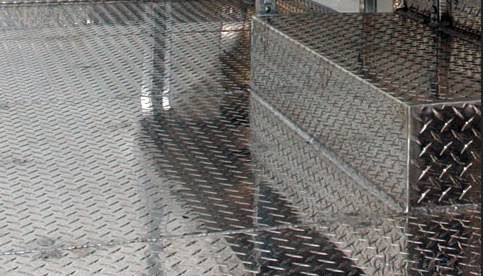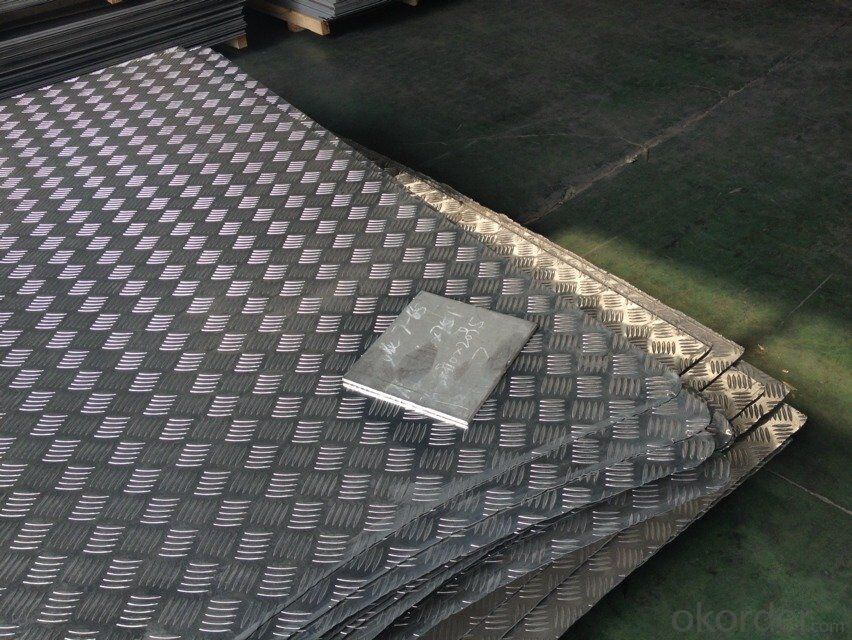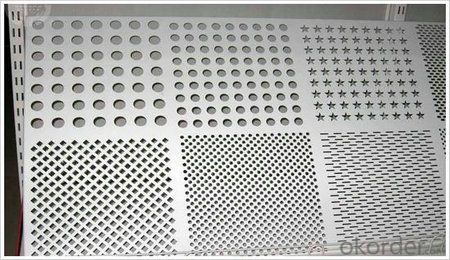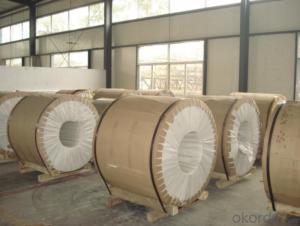Aluminum Coil / Plates / Sheets for Building Materials
- Loading Port:
- Shanghai
- Payment Terms:
- TT OR LC
- Min Order Qty:
- 5 m.t.
- Supply Capability:
- 10000 m.t./month
OKorder Service Pledge
OKorder Financial Service
You Might Also Like
Item specifice
Pattern: orange peel, aluminum sheet5 bar,half a ball,diamond,compass shape
1.Orange peel aluminum sheet/coil
1)Alloy :1060 1100 1050 3003 3004 3105 5052
2)Temper :0 H114 H24 H32
3) Specification thickness:0.2mm-3.0mm
width:50mm-1300mm
Length: according your request
4)Application: Refrigeration. Air-conditioner. keep warm well such as pipe ,tank
5)Surface: No crack,canker, hole
2. aluminum sheet5 bar/coil
1)Alloy :1060 1100 1050 3003 3004 3105 5052 5754 5083 6061 6063 6082
2)Temper: O H114H194 T6
3) Specification: Thickness:1.0mm-10mm
Width:50mm-2000mm
Length: according your request
4)Application: the main function is anti-skidding,widely used in automobile manufacturing,shipbuilding,machine manufacturing,elerator,workshop
5)Surface: No crack,canker, hole
3.Compass shape aluminum sheet/coil
1)Alloy:1060 1100 1050 3003 3004 3105 5052 5754 5083 6061 6063 6082
2)Temper: O H114 H194 T6
3) Specification: thickness:1.0mm-10mm
width:50mm-2000mm
Length: according your request
4)Application: the main function is anti-skidding,widely used in automobile manufacturing,shipbuilding,machine manufacturing,elerator,workshop
5)Surface: No crack,canker, hole
4.Diamond aluminum sheet/coil
1)Alloy:1060 1100 1050 3003 3004 3105 5052 5754 5083 6061 6063 6082
2)Temper: O H114 H194 T6
3) Specification: Thickness:1.0mm-10mm
Width:50mm-2000mm
Length: according your request
4)Application: building industry,packing,decorative
5)Surface: No crack,canker, hole
4) Delivery time: 15-20 days after confirming order.
For all above:
1) Minimum order quantity: 5 tons per size.
2) The term of payment: T/T, irrevocable L/C at sight.
3) Packing: Export standard, waterproof wooden,craft,plywood pallet,etc.





- Q:Are aluminum sheets suitable for construction purposes?
- Yes, aluminum sheets are suitable for construction purposes. They are lightweight, durable, and resistant to corrosion, making them ideal for various construction applications such as roofing, cladding, and structural components. Additionally, aluminum sheets offer good thermal and electrical conductivity, making them suitable for applications where these properties are required.
- Q:How do you prevent oxidation of aluminum sheets?
- To prevent oxidation of aluminum sheets, several methods can be employed. One common approach is to apply a protective coating or finish on the surface of the aluminum sheets. This coating acts as a barrier between the aluminum and the external environment, preventing the metal from reacting with oxygen and forming an oxide layer. There are various types of coatings available for this purpose, including anodizing, painting, and powder coating. Anodizing is a process that involves creating a controlled oxide layer on the surface of the aluminum through electrolysis. This oxide layer is highly resistant to corrosion and provides excellent protection against oxidation. Painting and powder coating involve applying a layer of paint or powdered polymer onto the aluminum surface. These coatings form a physical barrier that shields the metal from oxygen and moisture. Another effective way to prevent oxidation is by using aluminum alloys that have enhanced corrosion resistance. These alloys are specifically designed to have a higher resistance to oxidation and can withstand exposure to harsh environments without forming a significant oxide layer. In addition to coatings and alloy selection, proper storage and handling practices are crucial to prevent oxidation. Aluminum sheets should be stored in a clean, dry, and well-ventilated area to minimize exposure to moisture and corrosive elements. Any contact with acidic or alkaline substances should be avoided, as they can accelerate the oxidation process. Regular cleaning and maintenance of aluminum sheets also help in preventing oxidation by removing any contaminants that could promote corrosion. Overall, preventing oxidation of aluminum sheets involves a combination of protective coatings, appropriate alloy selection, and proper storage and handling practices. By implementing these measures, the lifespan and durability of aluminum sheets can be significantly improved.
- Q:Can aluminum sheets be used for roofing?
- Indeed, roofing can be done using aluminum sheets. The preference for aluminum in roofing material selection is attributed to its sturdy composition, low weight, and resistance to rusting. Aluminum roofing sheets have gained recognition for their impressive lifespan, capable of enduring for many years without requiring replacement. Furthermore, aluminum possesses exceptional reflective capabilities, aiding in reducing energy expenses by maintaining a cooler temperature within the structure in hot weather. Furthermore, aluminum is effortless to install, rendering it an appealing option for roofing ventures. In summary, aluminum sheets are a dependable and pragmatic alternative for roofing purposes.
- Q:Are 101 aluminum sheets suitable for chemical storage tanks?
- No, 101 aluminum sheets are not suitable for chemical storage tanks. Aluminum, especially 101 aluminum, is not resistant to many chemicals and can react with them, leading to corrosion and potential leakage. Chemical storage tanks require materials that are specifically designed to withstand the corrosive nature of chemicals, such as stainless steel or certain types of plastics. It is essential to use materials that are chemically resistant and can ensure the safety and integrity of the stored chemicals.
- Q:What are the different methods of joining aluminum sheets without welding?
- There are several methods of joining aluminum sheets without welding, including adhesive bonding, mechanical fastening (such as screws or rivets), clinching, and using non-welding techniques like friction stir welding or laser welding.
- Q:How are aluminum sheets manufactured?
- Aluminum sheets are manufactured through a process called rolling. The process starts with aluminum ingots, which are heated and then passed through a series of rolling mills. These mills apply pressure to the ingots, reducing their thickness and lengthening them at the same time. As the ingots pass through the mills, they are gradually transformed into thin sheets of aluminum. The rolling mills consist of a series of rollers, which are typically made of steel. The rollers rotate in opposite directions, and as the aluminum passes between them, it is squeezed and stretched. This continuous process of rolling helps to refine the aluminum's grain structure and improve its mechanical properties. To ensure the proper thickness and surface finish, the aluminum sheets may go through multiple passes in the rolling mills. Each pass gradually reduces the thickness of the sheet until the desired thickness is achieved. The final pass also imparts the desired surface finish. After the rolling process, the aluminum sheets may undergo further treatments such as annealing or surface treatments to enhance their properties or appearance. Annealing involves heating the sheets to a specific temperature and then cooling them slowly to relieve internal stresses and improve their strength. Once the sheets are manufactured and treated, they are typically cut into desired sizes and shapes. This can be done through shearing, which involves cutting the sheets with sharp blades, or by using specialized cutting machines. Overall, the manufacturing of aluminum sheets is a complex and precise process that involves heating, rolling, and treating the aluminum to achieve the desired thickness, finish, and properties.
- Q:How do you achieve a mirror-like finish on aluminum sheets?
- To achieve a flawless mirror-like appearance on aluminum sheets, a series of procedures must be undertaken to eliminate any flaws and create a sleek, reflective surface. The crucial steps involved are as follows: 1. Surface preparation: Commence by meticulously cleansing the aluminum sheet to eliminate any dirt, grease, or other contaminants. Utilize a mild detergent and water to accomplish this task. Thoroughly rinse the surface and ensure it is completely dry. 2. Sanding: Employ increasingly finer grades of sandpaper or abrasive pads to eliminate any scratches, oxidation, or unevenness on the aluminum surface. Begin with a coarser grit (around 120-180) and gradually progress to finer grits (up to 1000 or higher) to attain a smoother texture. It is essential to sand consistently in one direction to avoid visible scratches. 3. Polishing compounds: Administer a polishing compound or specialized metal polish designed explicitly for aluminum surfaces. Employ a soft cloth or a buffing wheel to apply the polish and work it into the surface. Apply gentle pressure and distribute the polish evenly by executing circular motions. Repeat this step until the desired level of shine is achieved. 4. Buffing: Utilize a buffing wheel, preferably composed of felt or cotton, to further enhance the luster. Apply a small quantity of a high-quality polishing compound to the wheel and meticulously buff the aluminum sheet in a consistent manner. Employ circular motions and maintain an unwavering, even pressure. 5. Final polishing: To attain an impeccable mirror-like finish, employ a specialized aluminum polish or a metal finishing compound. Apply a small amount onto a clean cloth and gently rub the surface using circular motions. This final step aids in eliminating slight scratches or imperfections, augmenting the brilliance of the aluminum sheet. Remember to meticulously cleanse the aluminum sheet after each step to eliminate any residue or excess polish. Furthermore, always adhere to the manufacturer's instructions when utilizing specific polishing compounds or tools as they may provide specific guidelines for optimal outcomes. By diligently following these steps, you can achieve a mirror-like finish on aluminum sheets, transforming them into highly reflective surfaces that are visually captivating and functionally efficient.
- Q:What are the common surface finishes for aluminum sheets?
- Some common surface finishes for aluminum sheets include mill finish, brushed finish, anodized finish, and powder-coated finish. Mill finish refers to the untreated surface of the aluminum sheet, which has a slightly rough texture and may have visible imperfections. This is the most basic and economical option, commonly used for industrial applications or as a base for further finishing processes. Brushed finish involves a mechanical brushing process that creates a series of fine parallel lines on the surface of the aluminum sheet. This finish gives the metal a textured appearance and can help to hide small scratches or imperfections. Anodized finish is achieved through an electrochemical process called anodization, which creates a protective oxide layer on the surface of the aluminum. This finish enhances the corrosion resistance and durability of the metal while also allowing for a variety of color options. Anodized aluminum sheets are often used in architectural applications or for decorative purposes. Powder-coated finish involves applying a dry powder to the surface of the aluminum sheet and then baking it at high temperatures. This process creates a durable and attractive finish that is resistant to chipping, scratching, and fading. Powder-coated aluminum sheets are commonly used for outdoor applications, such as building facades, signage, or automotive parts. Overall, the choice of surface finish for aluminum sheets depends on the desired appearance, functionality, and specific requirements of the application.
- Q:How do aluminum sheets perform in terms of electrical conductivity?
- Aluminum sheets are known for their excellent electrical conductivity, ranking just below copper in terms of efficiency.
- Q:What is aluminium plate L2-Y2?
- L2Y2 is an industrial pure aluminum sheet:1, L2: China's industrial pure aluminum grades are limited by impurities to prepare, such as L1, L2, L3...... L, is the "aluminum" word Pinyin prefix, followed by the attached order number is bigger, its purity is low. Industrial pure aluminum is generally defined as aluminum with a purity of 99% to 99.9%, and China is designated as 98.8% - 99.7% aluminum.
1. Manufacturer Overview |
|
|---|---|
| Location | |
| Year Established | |
| Annual Output Value | |
| Main Markets | |
| Company Certifications | |
2. Manufacturer Certificates |
|
|---|---|
| a) Certification Name | |
| Range | |
| Reference | |
| Validity Period | |
3. Manufacturer Capability |
|
|---|---|
| a)Trade Capacity | |
| Nearest Port | |
| Export Percentage | |
| No.of Employees in Trade Department | |
| Language Spoken: | |
| b)Factory Information | |
| Factory Size: | |
| No. of Production Lines | |
| Contract Manufacturing | |
| Product Price Range | |
Send your message to us
Aluminum Coil / Plates / Sheets for Building Materials
- Loading Port:
- Shanghai
- Payment Terms:
- TT OR LC
- Min Order Qty:
- 5 m.t.
- Supply Capability:
- 10000 m.t./month
OKorder Service Pledge
OKorder Financial Service
Similar products
New products
Hot products
Hot Searches
Related keywords
































